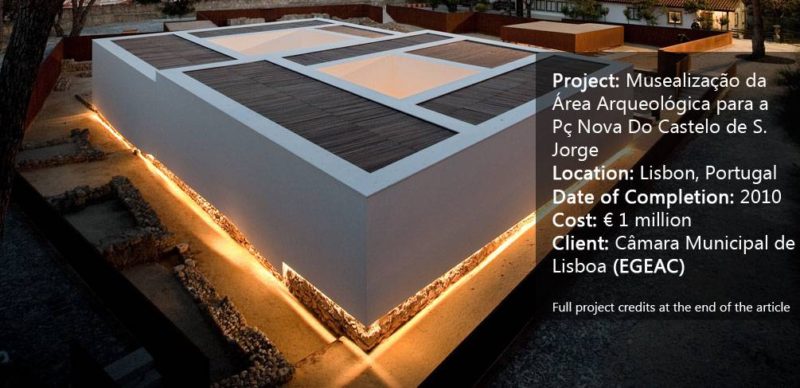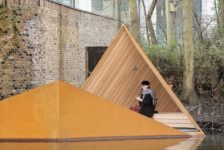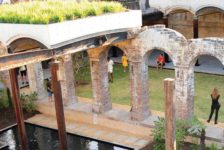Article by Elisa A.M.Varetti Musealização da Área Arqueológica para a Pç Nova Do Castelo de S.Jorge, by Global Arquitectura Paisagista and JLGS Arquitectos, Lisbon, Portugal. Have you ever stopped to wonder about the historic evolution of your own town? Most people think landscape architects only deals with green materials, parks, and gardens, but they can do a lot more! For example, they can work with archaeological areas and bring out what people have forgotten; their history and their tradition. Making people aware of what they have lost is a tough job but it clearly defines an important role for landscape architecture showing how it can interact with other sectors. And that’s exactly what happened when landscape architect João Gomes da Silva of Global Arquitectura Piasagista worked with Architect João Luìs Carrilho da Graça of JLCG Architects to restore the archaeological site of the S. Jorge Castle in Lisbon.

Musealização da Área Arqueológica para a Pç Nova Do Castelo de S.Jorge. Photo credit: Duarte Belo
This historical site is located on top of the hill occupied by the Castelo de São Jorge, the most ancient human settlement of Lisbon. The place was of course strategic, as it offered a total and complete view both of the estaury of the Tejo River, with its alluvial plain, and of the oceanic entrance and its inland territory. Cypresses, olive trees and pine trees cover the whole hill, giving visitors shade and a place to rest from the burning sun. But it’s actually the sunlight, going from golden mist in the morning to strong light during the day and to real gold in the evening, that gives this place a magical aura and it was probably the reason why our ancestors chose that place to settle down.

Musealização da Área Arqueológica para a Pç Nova Do Castelo de S.Jorge. Photo credit: Duarte Belo

Musealização da Área Arqueológica para a Pç Nova Do Castelo de S.Jorge. Photo credit: Fernando Guerra
Archaeological excavations began in 1996 and revealed occupation over many different historic periods. All of them can be experienced by visitors just by walking inside the site and following their curiosity. The area revealed a cemetery; as the most ancient settlement that can be referred as to the Iron Age, those people probably thought they would have honored their dead by burying them in this magical place. Other peoples took up residence here in the following centuries, such as the Muslims who built the Alcáçova near the mosque (today’s Stª Cruz Church) in the Medieval times, and the Clergy who built the Palace of the Bishop of Lisbon during the fifteenth century.

Musealização da Área Arqueológica para a Pç Nova Do Castelo de S.Jorge. Photo credit: Duarte Belo
The designers had to deal with ruins from different periods and decided to apply the “Archaeology Field” principles, isolating each historic time and considering this landscape as a palimpsest. “The contemplation and interpretation of these material culture remains is used as an instrument to construct the Place as a Palimpsest, where a sucessive layering of occupations were erased after the accumulation of soil and cataclism debris forming an indefinable juxtaposing of times and materials in a tridimensional field,” explain the designers. In this way they managed to create a place that people can visit and from which they can learn Portuguese cultural context as well as providing a method of protection for those remains.

Musealização da Área Arqueológica para a Pç Nova Do Castelo de S.Jorge. Photo credit: Duarte Belo
The landscape design follows the different time periods of the site and enhances them with sheets of COR-TEN steel which define the perimeter of the project and appear as the leitmotif of the whole project. By following them, visitors discover the historic evolution of the site and are overwhelmed by it. The first steps lead to a hovering structure that preserves the remains of the pavement with mosaics of the Bishop’s Palace while a black mirror, hidden in its underside, reflects them for the visitors’ view. Further down, visitors experience the spatial division of the eleventh-century Muslim domestic structures, whose ruins and frescos were found during the excavations. Here, white walls float above the original ruins while a translucent covering of polycarbonate and wood filters the sunlight. The last element to discover is the settlement from the Iron Age which is protected by a self-contained volume in COR-TEN with a spiral movement. Horizontal slits arouse visitors’ curiosity, getting them to walk around the structure and see this period’s ruins.

Musealização da Área Arqueológica para a Pç Nova Do Castelo de S.Jorge. Photo credit: Fernando Guerra

Musealização da Área Arqueológica para a Pç Nova Do Castelo de S.Jorge. Photo credit: Duarte Belo
To better valorize the place and its history, the designers decided to use natural-colored materials such as COR-TEN steel. The result is a design that perfectly merges with the surrounding landscape. Different paving materials reveal all the historic periods: black basalt defines the superior and contemporary layer, orange sand reveals the collective and private spaces of the Alcáçova, while a metallic structure retains the deepest excavation of the Iron Age.

Musealização da Área Arqueológica para a Pç Nova Do Castelo de S.Jorge. Photo credit: Duarte Belo
“
The basalt’s black, the sand’s orange and the steel’s red oxide, contrasting with the green of the pine and wild olive trees, form a new Place in which the Accumulated Time faces the enormous infinity of the sky, the estuary
and the alluvial plain. The Landscape regains the serenity that made the Place,”
say the designers. 
Musealização da Área Arqueológica para a Pç Nova Do Castelo de S.Jorge. Photo credit: Duarte Belo
The Museum-ization of the archaological site of S. Jorge’s Castle clearly shows that when architecture and landscape architecture meet history they are able to produce powerful and emotional designs. Here, landscape architect João Gomes da Silva and architect João Luìs Carrilho da Graça deeply analysed the place with its intricate and intriguing history. By considering the place as a palimpsest they managed to valorize the site thanks to a superb but simple design and the right choice of materials.

Musealização da Área Arqueológica para a Pç Nova Do Castelo de S.Jorge. Photo credit: Duarte Belo
Dealing with history is not easy, as our writer Terka Acton reminds us in her article about the renovation of a public place in Slovenia,
Can Landscape Architects Use History to Make a City Stronger? Or that our writer Paul McAtomney shows us in his article,
15 Great Examples of Historical Landscape Architecture, but working on an archaeological site is quite different and it’s not something everyone can do. It can be an intriguing opportunity for landscape architects who will have to design something powerful but at the same time remember that the most important thing here are remains and ruins and that’s the real challenge!

Musealização da Área Arqueológica para a Pç Nova Do Castelo de S.Jorge. Photo credit: Duarte Belo
Full Project Credits For Musealização da Área Arqueológica para a Pç Nova Do Castelo de S.Jorge:
Project Name: Musealização da Área Arqueológica para a Pç Nova Do Castelo de S.Jorge Location: Lisbon, Portugal Date of Construction: 2008 project, 2009 – 2010 construction Team: Global Arquitectura Paisajista/João Gomes da Silva (landscape architecture), JLCG Arquitectos/ João Luís Carrilho da Graça (architecture) Project Team: Francisco Freire, Vasco Melo, Pedro Abreu, Monica Ravazzolo Security Installations: GIPIC/Alexandre Martins Foundations and Structures: Estudos Betar / José Pedro Venâncio and Paulo Mendonça Water Installations: Estudos Betar / Marta Azevedo and Jorge Pinheiro Electrical Installations: Ruben Sobral Graphic Design: Henrique Cayatte, Mónica Lameiro and Pedro Gonçalves Area: 3.500 m2 Cost: € 1 million Awards: Piranesi Prix de Rome in 2010 Client: Câmara Municipal de Lisboa (EGEAC) Photographs: Fernando Guerra, Duarte Belo Recommended Reading:
Article by Elisa A.M.Varetti
Published in Blog


















